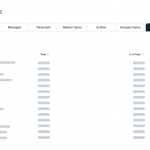How Modern Contact Centers Are Driving Revenue and Profitability
How Modern Contact Centers Are Driving Revenue and Profitability

Does contact center performance impact the profitability of an organization? In our “State of the Contact Center 2022” survey, contact center managers shouted, “Yes!” A whopping 88% of contact center managers around the world said their customer service has a direct impact on revenue and profitability.
And let’s be clear: These managers aren’t biased. A recent McKinsey report backs them up. Analysts estimate that companies can increase topline revenues by 10-20% by turning customer service into a revenue-generating engine—an approach McKinsey calls “Customer Value Execution.”
But what does it mean for the contact center to move from a cost center to a profit center? What’s holding contact centers back from embracing their role as revenue generators? And how can contact centers build targeted strategies to grow revenue and improve profitability?
From Pressure-Release Valve to Customer-Retention Key
Over the past decade, businesses significantly changed how they think about the role of the contact center. Nearly all businesses today compete on the basis of customer experience (CX). Statistics abound around how quickly customers defect after poor service experiences. And the cost of that customer defection? Forbes estimates businesses lose $75 billion annually due to poor customer service—and Accenture thinks that figure could be as high as $1.6 trillion.

Those numbers make it much easier for business leaders to justify investing in the contact center as more than a pressure-release value. Yet there are plenty of business leaders that still have the minimum viable product (MVP) mindset when it comes to the contact center. That’s because looking at the contact center solely as a driver of customer retention limits its value to risk mitigation rather than value creation. And risk mitigation naturally lends itself to the MVP mindset—not the proactive, substantive investments that, say, sales or R&D might get.
The Contact Center Proves Itself as a Revenue Generator
An overwhelming 97% of consumers in our “State of the Contact Center 2022” survey say the contact center is very impactful on brand loyalty. With 75% of consumers now making decisions based on brand loyalty and brand experience alone, delivering outstanding customer experience directly drives revenue and profitability.
Research supports how contact center experiences can drive revenue across multiple fronts:
• Contact center interactions impact brand loyalty: In our “State of the Contact Center 2022” survey, 97% of consumers say contact center interactions impact their brand loyalty. And 2 in 3 consumers say those interactions are very or extremely impactful.
• Contact center experiences create price premiums: A study sponsored by Zendesk found that 3 in 4 (75%) of customers say they’re willing to spend more to buy from businesses that deliver a good CX. And a PricewaterhouseCoopers study concluded that great CX is worth a 16% price premium on products and services—and that’s on top of the value of increased customer loyalty.
• Contact center interactions are prime sales opportunities: Research by Marketing Metrics estimates that brands have a 14x greater probability of cross-selling an existing customer (through a contact center service-to-sales approach) than selling to a new prospect.
• CX leaders see 3x revenue growth: Finally, a comprehensive study by the IBM Institute for Business Value found that “Experience Leaders” generate 3x more revenue than their peers—a direct result of their leadership in CX innovation and higher customer satisfaction.

The Contact Center Proves Itself as a Revenue Generator
The statistics above paint a promising picture of the contact center as a profit center. But until now, much of this revenue generation has been a secondary outcome of CX investments—a happy accident, so to speak. The next few years will see leading contact centers confidently claim their roles as profit centers, implementing targeted strategies to drive revenue and boost profitability.
Here’s a simple look at how forward-thinking Calabrio customers are building a revenue-generating playbook:
1) Get 360° visibility to effectively measure customer lifetime value.
According to a TalkDesk report, 72% of CX professionals say that positioning their contact center as a profit center is important to their business. The subtext of that stat: Most don’t feel they’re there yet. So what’s holding them back? A big problem is that most contact centers struggle to effectively measure customer lifetime value (CLV). And CLV is critical to understanding the revenue-generating capabilities of contact center experiences—because those impacts aren’t immediate and obvious.
Consider a customer calling with an issue: Great service and a fast, effective resolution can easily turn a negative experience into a profoundly positive, lasting impression. But that doesn’t mean the customer is ready to buy more right then.
Calabrio customers are using their 360° customer visibility—across every channel and every touchpoint—to connect the incremental value of these positive service experiences. They’re going beyond tracking customer retention, visualizing patterns and trends in how positive interactions boost spending later on—ultimately driving a higher CLV.
2) Map the customer journey to identify your opportunities.
That same omnichannel customer visibility enables leading Calabrio customers to map out their customer journeys so they can see the common trajectories and define their key touch points. With these journeys clearly mapped out, they’re identifying the easy and natural cross-sell and upsell opportunities as the basis for their revenue-generating playbooks.
3) Use AI to trigger sales insights for agents.
Most contact centers are already using AI and automation to empower agents to deliver more personalized experiences: recognizing the customer across channels, making the customer feel known, anticipating their needs, and never making them repeat basic information. Some Calabrio customers are now utilizing this same AI-driven automation to power the service-to-sales model.
Sophisticated AI-powered agent dashboards can instantly look at a customer journey, recognize an opportunity, and trigger a cross-sell or upsell notification or script for an agent. Not only does this make things remarkably easy for agents, but it also makes the service-to-sales model feel natural and assistive to the customer—giving them hyper-relevant recommendations that add value to their experience, rather than feeling sold to.
4) Use analytics to understand what closes the sale—and train your agents.
One of the biggest challenges in the service-to-sales approach is transforming your agents into effective salespeople. And that challenge starts with the traditionally subjective nature of defining what closes a sale.
Calabrio Analytics takes away this guesswork and replaces intangibles with data-driven insights on what works and what doesn’t. Contact centers are using Calabrio Analytics to look across all their customer interactions, identifying the successful sales and diving into the words, sentiments, and syntax used by the agent and the customer. They’re mapping out the anatomy of successful sales conversations—and building out data-driven best practices to inform agent sales training.

Bluegrass Success story on analytics:
5) Use agent engagement and performance tools to motivate sales.
Skills are one part of the equation—motivation is the other. But traditional metrics like average handle time (AHT) and first-contact resolution (FCR) make it difficult to motivate agents to shift their focus from fast service to value-added selling. A final key, then, is building out a new set of metrics that align with sales performance and revenue generation. This gives agents a clear understanding of what they’re aiming for.
Some of the most innovative contact centers are leveraging Calabrio’s agent engagement and performance coaching tools to give agents visibility into how they’re performing as they make this monumental shift in role. They’re using Calabrio’s performance benchmarking and AI-driven gamification to give agents real-time feedback and inspire self-improvement, helping to turn their agents into powerful sales drivers.
Contact Center Leaders Must Jump on Their Opportunity to Become a Profit Center
The convergence of customer expectations and market forces are putting the spotlight on the contact center in profound new ways. Business leaders are seeing the broader opportunities that come from exceptional contact center experiences—and they’re eager to find new CX-driven strategies. Consumers are receptive to the service-as-sales model, as it’s a natural extension of the hyper-personalized, hyper-relevant, assistive service experience they’ve come to expect.
Contact center leaders need to grab hold of this opportunity and claim their seat at the table as a revenue generator. But to deliver on that promise, they need to put together the right combination of strategy and technology to support this new service-to-sales model. The good news? These technologies are already available, and leading contact centers have already begun defining the playbook for using these same analytics, AI, and automation tools to build a revenue-generating CX engine.
For more trends and insights to help your contact center grow, check out the latest “State of the Contact Center” report.








